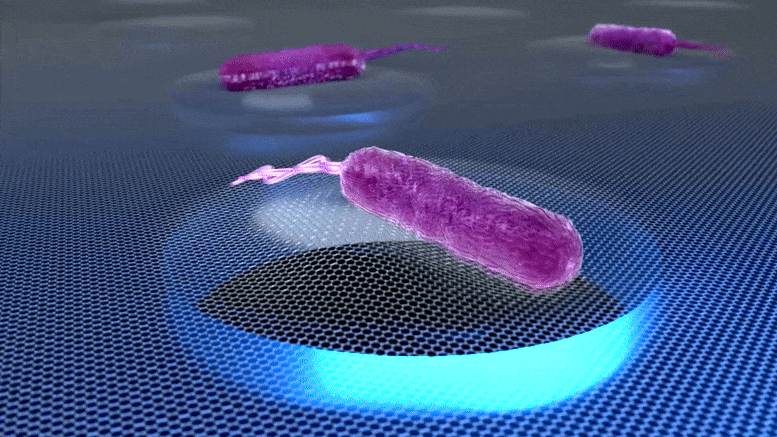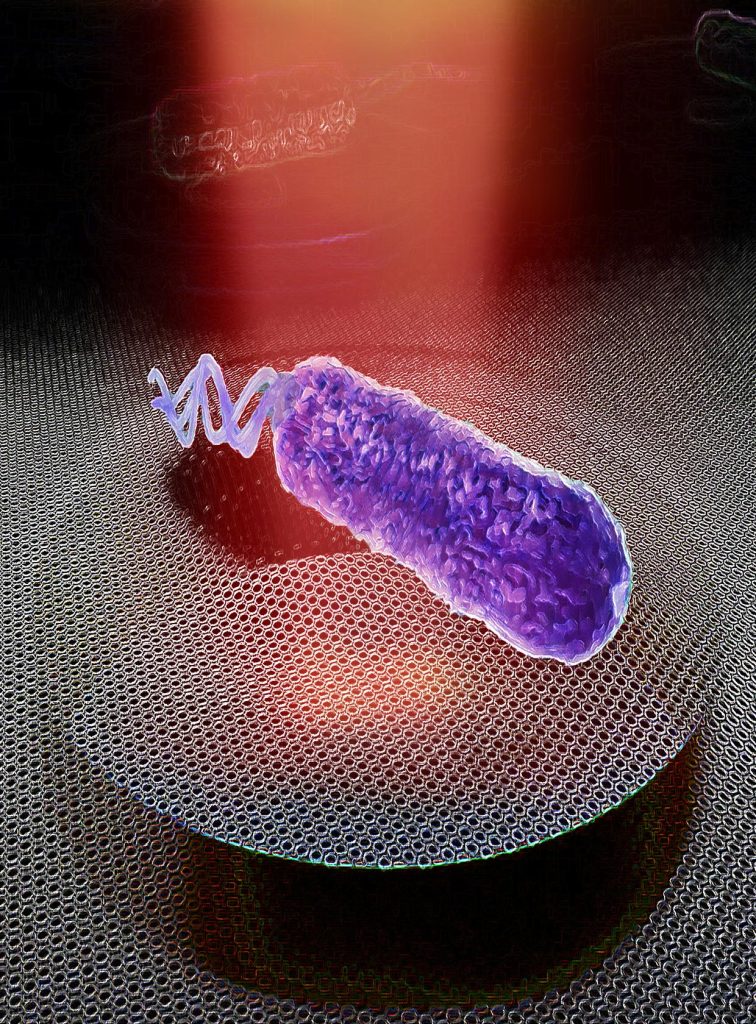
A graphene drum can reveal the sound of bacteria.
Have you ever wondered if bacteria make distinctive sounds? If we could listen to bacteria, we would be able to know whether they are alive or not. When bacteria are killed using an antibiotic, those sounds would stop – unless of course, the bacteria are resistant to the antibiotic. This is exactly what a team of researchers from TU Delft, led by dr. Farbod Alijani, has now managed to do: they captured low-level noise of a single bacterium using
This animation shows how a graphene drum can reveal the sound of bacteria. The sound stops when a bacterium is killed by an antibiotic. Credit: Irek Roslon – TU Delft
Farbod Alijani’s team of researchers initiated a collaboration with the nanobiology group of Cees Dekker and the nanomechanics group of Peter Steeneken. Together with PhD student Irek Roslon and postdoc Dr. Aleksandre Japaridze, the scientists ran their first experiments using E. coli bacteria. Cees Dekker: “What we saw was striking! When a single bacterium adheres to the surface of a graphene drum, it generates random oscillations with amplitudes as low as a few nanometers that we could detect. We could hear the sound of a single bacterium!”
Punching a graphene drum with a bacterium
The extremely small oscillations are a result of the biological processes of the bacteria with main contribution from their flagella (tails on the cell surface that propel bacteria). “To understand how tiny these flagellar beats on graphene are, it’s worth saying that they are at least 10 billion times smaller than a boxer’s punch when reaching a punch bag. Yet, these nanoscale beats can be converted to sound tracks and listened to — and how cool is that,” Alijani says.

Artist’s impression of a graphene drum detecting nanomotion of a single bacterium. Credit: Irek Roslon, TU Delft
Graphene for fast detection of antibiotic resistance
This research has enormous implications for the detection of antibiotic resistance. The experimental results were unequivocal: If the bacteria were resistant to the antibiotic, the oscillations just continued at the same level. When the bacteria were susceptible to the drug, vibrations decreased until one or two hours later, but then they were completely gone. Thanks to the high sensitivity of graphene drums, the phenomenon can be detected using just a single cell.
Farbod Alijani: “For the future, we aim at optimizing our single-cell graphene antibiotic sensitivity platform and validate it against a variety of pathogenic samples. So that eventually it can be used as an effective diagnostic toolkit for fast detection of antibiotic resistance in clinical practice.” Peter Steeneken concludes: “This would be an invaluable tool in the fight against antibiotic resistance, an ever-increasing threat to human health around the world.”
Reference: “Probing nanomotion of single bacteria with graphene drums” by Irek E. Rosłoń, Aleksandre Japaridze, Peter G. Steeneken, Cees Dekker and Farbod Alijani, 18 April 2022, Nature Nanotechnology.DOI: 10.1038/s41565-022-01111-6
I have read your article carefully and I agree with you very much. This has provided a great help for my thesis writing, and I will seriously improve it. However, I don’t know much about a certain place. Can you help me?